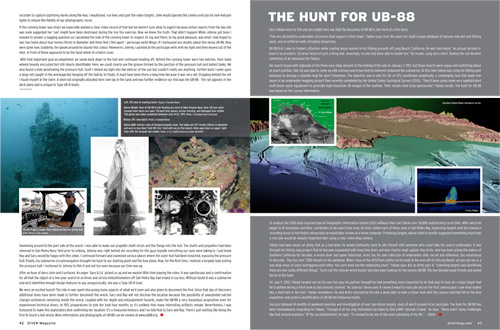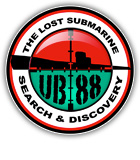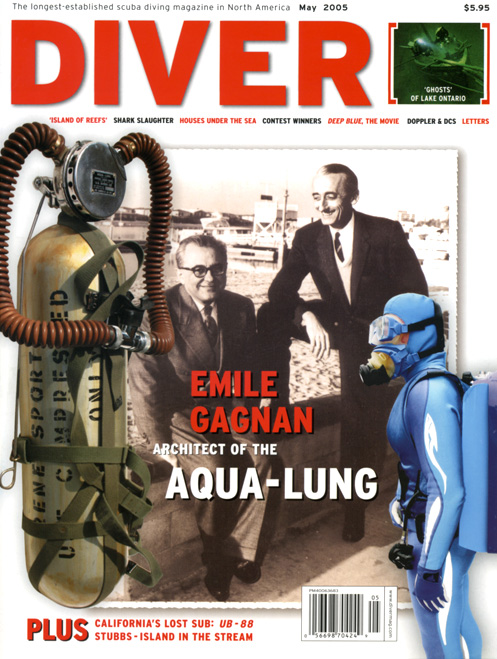
Diver Magazine, May
2005 Issue
Reprinted with permission
UNTERSEEBOOT
UB-88
LOST
FOR 82 YEARS, WWI GERMAN U-BOAT
FOUND IN SAN PEDRO BAY CALIFORNIA
Submarine
Warfare
‘TERRIFYING’ NEW THREAT BENEATH THE SEA
BY BRENDAN COYLE
The First World War was a catalyst for the development of
new and terrifying weapons and the war at sea was no
exception. By 1916 trench warfare had stalled the bloody
conflict. Britannia’s invincible navy was squeezing
Germany of the vital resources she needed from her colonies
to continue the fight. Comparatively, Great Britain’s
supply line was unimpeded. Allied convoys from North
America were successfully crossing the Atlantic. The German
high command saw the Unterseeboot – the submarine
– as a means of blockading England, effectively
starving her, an action they believed ultimately would
cause Britain to sue for peace.
Until this time submarines were largely untested in war.
Prevailing opinion was that they were too small to carry
the crew necessary to man captured ships or to take
prisoners aboard. As a weapon against civilian shipping,
they had been dismissed as ineffective. This thinking
changed and in February of 1915, Germany declared its
solution to the problem: Unrestricted Submarine Warfare.
Merchant ships would be fired upon and sunk, crew and all,
no capture necessary. The declaration defined a war zone
around the British Isles within which Germany would sink
any allied merchant vessel on sight. In the ensuing eight
months 50 ships fell victim to the Imperial Navy’s
Unterseeboot, including the liner Lusitania, with the loss
of 1,198 lives, of which 198 were Americans. The world was
shocked and America outraged. Fearing America’s entry
into the war the German’s backed off, but only for a
while. With a strong fleet of submarines in service by
February 1917, Germany again declared its policy of
unrestricted submarine warfare only this time all ships,
allied and neutral would be game. By April the United
States had entered the war.
The German submarine was viewed as sinister by the allies,
their tactics ungentlemanly and it was argued the enemy
submariners should be tried as war criminals when captured.
Submarine warfare had been given priority by the Germans
and their success was far greater than that of allied
countries. In May 1916, orders were given to construct a
new class of U-boat, the UB-III. While earlier submarines
were designed mainly for coastal operations the new UB-III
was bigger, faster, carried more crew and armaments. With a
range of 9,942 miles (16,000 km) plus, the 34-man crew
could take the war farther out in the Atlantic to intercept
vital shipping. These boats carried 10 torpedoes and an
88mm deck gun. Six of the new UB-III class boats were built
at Vulcan Werks in Hamburg and were the forerunner of
Germany’s deadly WW II U-boats.
The UB-88 was placed in commission 26 January 1918, under
Oberleutnant zur See Johannes Ries with the 1st Submarine
Flotilla based at Zeebrugge on the Belgian coast. In short
order Ries sank the 1,555-ton (1,580 tonnes) Swedish
steamer SS Dora and subsequently survived a depth charge
attack. Steamships Avance, Afrikan Transport, Moorlands,
Sixth Six, Florentia, Lake Portage, Berwind, Hundvaago,
Philomel, Fanny, Polesley were all sent to the bottom by
UB-88 for a total of 32,340 tons (32,850 tonnes) over her
short war service of five patrols. She survived five known
counter-attacks. The sub damaged the freighter Anselma and
was partially responsible for damage inflicted to the
British steamer Bayronto when a torpedo fired from a French
destroyer missed the U-boat and struck the allied ship.
Following the end of hostilities on November 11, 1918,
UB-88 surrendered at Harwich, England, on November 27,
1918, where she was moored and her crew interned. On March
13, 1919, six German U-boats of various classes, among them
UB-88, were allocated to the United States Navy by the
British Admiralty for research and use in the
‘Victory War Bond’ drive. Under the American
flag and manned by a U.S. navy crew, UB-88 departed Harwich
on April 3 and arrived in New York April 27, 1919. During
her extensive tour of the United States UB-88 made calls to
ports along the Atlantic coast, the Gulf of Mexico, the
Mississippi River, the coast of Panama while transiting the
canal, and along the U.S. west coast as far north as
Seattle, Washington, steaming a total of 15,361 miles
(24,720km). Forty-five cities were visited, and over
400,000 visitors were shown through the boat before she
made her final destination November 9, the San Pedro Naval
Yard in California. The once formidable hunter was
decommissioned November 1, 1920, and stripped of most
machinery and fittings. On January 3, 1921, UB-88 was towed
to an area off Los Angeles in San Pedro Bay and (in
accordance with WWI peace treaty terms) was sunk by gunfire
from the destroyer USS Wickes, whereupon she disappeared
for 82 years.
Long the dream of many Los Angeles-area divers to find
UB-88, the antique submarine eluded discovery until local
sport fisherman Gary Fabian took an interest. A non-diver,
Fabian partnered with long time dive boat operator Ray
Arntz, who had also been searching for the elusive sub. The
pair had completely differing views on where the sub might
be located. Fourteen months of weekend searches culminated
July 9, 2003, when Fabian registered a positive
‘hit’ with his fish-finding sonar. (((the
high-resolution digital imagery provided by the U.S.
Geological Survey (see sidebar))) When drop camera video
footage confirmed the hit was, indeed, a wreck, the search
team expanded, initially to include technical divers
Kendall Raine and John Walker, and later Scott Brooks and
Fred Colburn.
Sonar indicated the wreck was reasonably intact and on
August 27, Raine and Walker made the initial dive, becoming
the first to lay eyes on UB-88 (to the best of
everyone’s knowledge) since her sinking 82 years
earlier. A slender, preserved hull, diving planes, torpedo
tubes conning tower, two shell holes from the USS
Wickes’ four-inch deck gun and a measured length of
190 feet (58m) and 19-foot (5.75m) beam confirmed the wreck
to be the elusive UB-88 (see accompanying story). Fabian
has not revealed the location or depth of UB-88 but says
she is well beyond the range of sport diving.
Before being scuttled, the submarine was stripped of most
fixtures. Much of the nautical brass fittings usual on a
wreck of this vintage were manufactured from steel out of
wartime necessity. The brass props were removed before her
sinking (see sidebar). Inside the wreck is a 25-pound cache
of TNT intended to sink UB-88 had the shellfire proved
ineffective. The shells did the job, however, one of them
severing the cable link between the submarine and a
stand-by vessel, preventing detonation of the high
explosives had it been necessary.
UB-88 was an advanced weapon in mankind’s first
‘global’ conflict. The U.S. Navy learned a
great deal about German submarine technology from her and
much of that knowledge played an important, perhaps
decisive, role in the development of the highly successful
American submarine force of the Second World War.
Meanwhile, UB-88 lies in state – her gray wartime
paint replaced by orange and strawberry anemones, rockfish
lulling in and out of the torpedo tubes that wrought the
death of 13 merchant steamers – a haunting relic of
the Great War.
The author and Diver Magazine thank Gary Fabian and Kendall
Raine for their assistance in presenting this story.
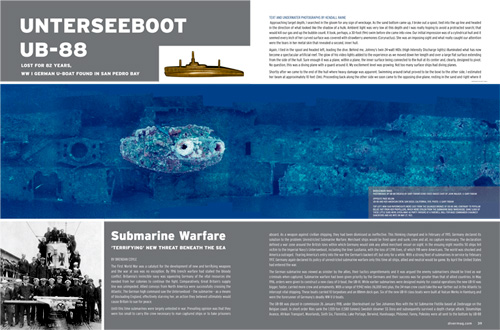
TEXT AND
UNDERWATER PHOTOGRAPHS BY KENDALL RAINE
Approaching target depth, I searched in the gloom for any
sign of wreckage. As the sand bottom came up, I broke out a
spool, tied into the up line and headed in the direction of
what looked like the shadow of a hulk. Ambient light was
very low at this depth and I was really hoping to avoid a
protracted search; that would kill our gas and up the
bubble count. It took, perhaps, a 30-foot (9m) swim before
she came into view. Our initial impression was of a
cylindrical hull and it seemed every inch of her curved
surface was covered with strawberry anemones (Corynactus).
She was an imposing sight and what really caught our
attention were the tears in her metal skin that revealed a
second, inner hull.
Again, I tied in the spool and headed left, leading the
dive. Behind me, Johnny’s twin 24-watt HIDs (High
Intensity Discharge lights) illuminated what has now become
a spectacular artificial reef. The glow of his video lights
added to the experience as we moved down her length and
over a large flat surface extending from the side of the
hull. Sure enough it was a plane, within a plane, the inner
surface being connected to the hull at its center and,
clearly, designed to pivot. No question, this was a diving
plane with a guard around it. My excitement level was
growing. Not too many surface ships had diving planes.
Shortly after we came to the end of the hull where heavy
damage was apparent. Swimming around (what proved to be the
bow) to the other side, I estimated her beam at
approximately 10 feet (3m). Proceeding back along the other
side we soon came to the opposing dive plane, resting in
the sand and right where it should be. Here we also found a
large opening in the outer hull. It was the anchor housing.
This was getting to be more fun all the time! Continuing
along the hull, I kept looking up hoping to see the conning
tower. That would clinch it, in my view. Less than a minute
later, there it was rising 15 feet (4.5m) above the main
hull. It was smothered in the little crimson anemones, too,
and was an impressive structure looming up as it did
against the green backlight. That nails it, I said to
myself. We’ve found her!
This extraordinary day began six weeks earlier with an
e-mail from Captain Ray Arntz whose intriguing note had
said: “Give me a call, I think I’ve got a
project.” A ‘project’ with Captain Ray
usually means one thing, there’s a newfound wreck to
be explored.
The news was better than I could have imagined. The wreck
that Ray and his partner Gary Fabian believed they had
located was not only newly discovered, but of the only
German U-boat known to be in California waters – the
famed First World War UB-88. They even had drop-camera and
digital sonar images of her. Wow! Ray and I had been
discussing the UB-88 for a long time and I’d dived on
several deep rock piles in search of this elusive war
machine. Now, unexpectedly, pay dirt! For years rumors
circulated that someone had coordinates for the sub and
even that it had been found. But rumours they were; nothing
definitive had ever surfaced. As far as I could tell,
we’d be the first to dive this historic wreck.
The UB-88 was a Type UB III German submarine built in
Hamburg, Germany and commissioned in January 1918. Despite
her late entry to the war, UB-88 managed to sink 13 ships
and damage two more during 10 months of service. She was
one of six WWI U-boats presented to the U.S. by Great
Britain when hostilities ended. Sailed back to the States
by an American crew, UB-88 was paraded around the eastern
seaboard as part of the Victory Bond drive before departing
for California via the Panama Canal. Based at the San Pedro
naval yard in southern California, UB-88 also cruised the
west coast raising money needed to help pay for the war
until 1921, when she was stripped and sunk in a live fire
exercise.
The fact Captain Ray had contacted me was a clue that the
wreck was deep. I’ve been technical diving for years
and Ray was looking for divers who could get the job done
and keep a lid on the project until it was time to go
public. “We need some video to nail it as the UB-88.
Can you do it?” Ray asked. Hmm, let me think about
that...split second pause...“Of course!” I
responded. “This is top secret,” he said.
“My partner Gary and I have worked too long and too
hard to have this get out. No screw-ups and no show
boating.” He asked who I’d dive with so I told
him my friend Johnny Walker and I would be cave diving in
Mexico until August 23. We set a date for the (27th)
Wednesday following our return.
“We’ll use my partner’s boat,” Ray
had said, “Gary (Fabian) actually found the wreck and
if you think I’m good at finding stuff, you should
see this guy!” Gary’s boat is moored at Long
Beach (just south of Los Angeles) and a few weeks later it
was there we met other members of the project team, Mike
Lapinski and Harry Davis. Mike was to assist Ray in the
hooking and gearing-up process. Harry would shoot topside
video and Gary, topside stills, when he wasn’t
running the boat. We loaded our gear quickly and headed out
to sea. We’d be diving double 104s with a15/50 mix
and the deco gas necessary for a 25-minute dive at the
target depth. Running at 15 knots, the trip would take us
under an hour on our southeasterly heading to the wreck
site.
Gary had been tenacious searching for UB-88 and Ray was
quick to give him credit as the driving force on the
project. Their combined enthusiasm coupled with the air of
anticipation on the boat that day was downright infectious.
Reviewing the drop-camera footage shot the month before, I
could see why their confidence about this site was so high.
The images were definitely not of a rock pile! The
structure we saw in a few clear frames bore resemblance to
deck plans of a Type UB III World War I German submarine.
Sonar readings suggested the target was largely intact and
about 175 feet (53m) in length. The UB-88 was 182 feet long
(55m) with a 19-foot (6m) beam.
Gary found the wreck on the first pass and Ray marked it
with a float. Our dive plan was to tie the up line into the
wreck and swim both sides using the video recorder to
capture signifying marks along the way. I would lead, run
lines and spot the video targets. John would operate the
camera and use his new Halcyon lights to ensure the
fidelity of our photographic recon.
If the conning tower was intact we especially wanted a
clear video record of that but we weren’t sure what
to expect because action reports from the day she was sunk
suggested her ‘sail’ might have been destroyed
during the live fire exercise. Now we knew the truth. That
didn’t happen! While Johnny got busy I needed to
answer a nagging question so I ascended the side of the
conning tower to inspect its top and there, to my great
pleasure, was what I had hoped to see: two holes about four
inches (10cm) in diameter and three feet (.9m) apart
– periscope wells! Bingo. If I harboured any doubts
about this being UB-88, they were gone now. Suddenly, the
gloom around me blazed into colour. Heeeeere’s
Johnny. I pointed at the periscope wells with my light and
then moved out of the shot. In front of these appeared to
be the hand wheel of a hatch cover.
With that important goal accomplished, we swam back down to
the hull and continued heading aft. Behind the conning
tower were two hatches, their hand wheels heavily encrusted
but still clearly identifiable. Here, we could clearly see
the groove formed by the junction of the pressure hull and
ballast tanks. We also found a hole penetrating the
pressure hull. Cool! I shined my light into the interior of
the sub but couldn’t really see anything. Further
back I came upon a large net caught in the wreckage but
hanging off the hull by its fl oats. It must have been
there a long time because it was very old. Dropping behind
the net I found myself at the stern. A steel rail
originally attached here now lay in the sand and was
further evidence our find was the UB-88. The rail appears
in the deck plans and is unique to Type UB III boats.
Swimming around to the port side of the wreck, I was able
to make out propeller shaft struts and the flange into the
hull. The shafts and propellers had been removed in San
Pedro Navy Yard prior to sinking. Johnny was right behind
me recording for the guys topside everything our eyes were
taking in. I just knew Ray and Gary would be happy with
this video. I continued forward and examined various places
where the outer hull had been breached, exposing the
pressure hull. Finally, my submarine circumnavigation
brought me back to our starting point and the bow plane.
Now, for the first time, I noticed a torpedo tube exiting
the pressure hull. I motioned to Johnny to film it and not
too soon because our time was up.
After an hour of deco John and I surfaced. An eager
‘Gary & Co.’ picked us up and we wasted
little time playing the video. It was spectacular and a
confirmation for all that the object of a two-year search
in archives and across miles/kilometers off San Pedro Bay
had ended in success. Without doubt it was a submarine and
we’d identified enough design features to say,
unequivocally, she was a Type UB III boat.
We were an excited bunch! The ride in was spent discussing
many aspects of what we’d seen and also plans to
document the find. Since that day of discovery additional
dives have been made to further document the wreck. Gary
and Ray will not disclose the location because the
possibility of unexploded satchel charges (ordnance)
remaining inside the wreck, coupled with her depth and
entanglement hazards, make the UB-88 a very hazardous
proposition even for experienced technical divers. In 1921,
preparations to sink her took four months so it’s
unlikely that many interesting artifacts remain.
Nevertheless, I was honoured to make this exploratory dive
confirming her location; it’s a treasured memory and
I’ve told that to Gary and Ray. There’s just
nothing like being the first to touch a lost wreck.
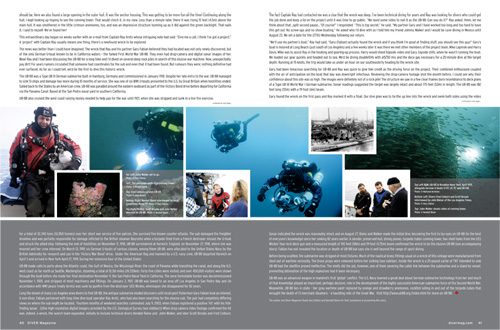
THE HUNT
FOR UB-88
Gary Fabian loves to fish and you might even say that the
discovery of UB-88 is one heck of a fish story.
“Fish are attracted to underwater structures that
support a food chain,” Fabian says. Over the years
he’s built a large database of natural rock and reef
fishing spots, and of artificial reefs, including
shipwrecks.
UB-88 first came to Fabian’s attention while reading
about wrecks in his fishing grounds off Long Beach,
California. He was fascinated. “An actual German U-
boat in local waters. I’d never heard of such a thing
and, amazingly, no one had been able to locate her,”
he recalls. Long story short, finding the sub became
something of an obsession for Fabian.
His search began with logbooks of the three navy ships
present at the sinking of the sub on January 3, 1921, but
those reports were vague and conflicting about an exact
position. Still, he was able to come up with a broad search
box that he believed contained the submarine. At this time
Fabian was using his fishing spot database to develop a
saleable map for sport fishermen. The objective was to plot
his list of GPS coordinates graphically, a challenging task
that made him aware of an underwater mapping project then
recently completed by the United States Geological Survey
(USGS). “They’d been using some very
sophisticated multi-beam sonar equipment to generate
high-resolution 3D images of the seafloor. Their results
were truly spectacular,” Fabian recalls. The hunt for
UB-88 was based on this survey information.
To analyze the USGS data required special Geographic
Information System (GIS) software that cost Fabian over
$6,000 and learning curve time, after which he began to ID
anomalies and their coordinates in his search box area. He
then visited each of these sites in San Pedro Bay,
inspecting targets with his Lowrance recording sonar (a
fish finder) whose data he would later review on a home
computer. Promising targets, whose relief or profile
suggested something more than a rock pile would be visually
inspected later using a color video drop camera.
Fabian had been aware all along that as a non-diver he
would eventually need to ally himself with someone who
could take the search underwater. It was through his
fishing map project that he became acquainted with long
time diver and dive charter boat captain, Ray Arntz, who
has been plying the waters of Southern California for
decades. A wreck diver and spear fisherman, Arntz has his
own collection of underwater sites, secret and otherwise,
too voluminous to describe. “Ray has over 7,000
targets on his database. When I look at the GPS/Chart
plotter on his boat in the area off of LA/Long Beach, all
you can see is a one large mass of icons overlapping each
other. You can’t even see the underlying
chart,” Fabian says. But as Arntz puts it,
“collecting targets and identifying them are two
vastly different things.” Turns out the veteran wreck
hunter had also been looking for the elusive UB-88. The two
became good friends and joined forces in the hunt.
On July 9, 2003, Fabian headed out on his own (he says his
partner thought he had something more important to do that
day) to look at a single target that he’d spotted
during a fresh look at data already covered. “As soon
as I drove over it I knew it wasn’t a rock pile and
on the first camera pass I saw what looked like a shell
hole in the hull,” Fabian remembers. He and Arntz
returned to the site a week later to take a closer look
with the camera and that led to the dive expedition and
positive identification of UB-88 the following month.
Success followed 14 months of weekend searches and
investigation of over two-dozen targets, most of which
proved to be rock piles. The hunt for UB-88 has been
tremendously rewarding for Fabian. “Through it all my
only motivation has been to find a WW I German
U-boat,” he says. “There aren’t many
challenges like that around anymore.” Of the
accomplishment, he says: “it’s proved to be one
of the most satisfying of my life.” Editor
